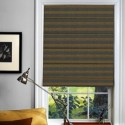The use of texture in home interior design has been extremely popular over the past several years, with the use of natural materials up sharply, as well. Woven wood or grass shades can be found everywhere – in traditional homes and contemporary settings. Read on to find out the good, the bad and the ugly about this type of window treatment…
Woven wood shades are made from natural materials such as grass, bamboo, jute, thin strips of wood and sometimes even paper. These natural materials provide a look that cannot be fully duplicated by a man-made material, creating a one-of-a-kind look at the window. This unique look is what draws many homeowners to woven wood or grass shades – their shade will look like no one else’s will.
The natural materials also add texture to any room, imparting a “bringing the outdoors in” vibe to a room. They can work in nearly any home, from Victorian traditional to Asian modern; simply choosing a shade made from one material or another can drastically change the look of the treatment.
Woven wood shades are also fairly versatile, since they can be used with or without a privacy or light-control backing. Adding a fabric backing will increase the privacy (in the case of a translucent fabric) or decrease the light coming into a room (in the case of an opaque fabric). A backing can also enhance the look of the wood or grass by contrasting with the weave of the shade and accenting its texture.
Woven wood shades can be made into roller shades or (more commonly) Roman shades, and even options for patio doors. Some versions even come in top down/bottom up operating systems, allowing privacy at the bottom of the window while the top is open to capture the light. With the addition of decorative tapes, which bind the edges of the shade or its built-in valance, you can create a unique look in every space by adding more color or texture to the shade.
However, woven wood and grass shades aren’t for everyone. The very same natural materials that appeal to one homeowner may drive another one crazy!
Natural materials are not man-made (duh!), so they cannot be fully controlled. This means that your shade will not look exactly like the sample you were shown. You need to be happy with a shade that has its own unique look and character.
These natural materials also mean that, unless you bind the edges with decorative tapes, the shade will be slightly ragged and uneven at the edges. The grass can fray over time. This unevenness can also create larger gaps between the shade and the window frame, which may let in more light and lessen the privacy of the room.
In addition, natural materials are susceptible to changes due to sunlight and moisture levels. Over time, especially on shades utilizing wood slats or bamboo rods, parts of the shade may warp or fade; these changes are a part of the deal, and you must be okay with this type of “living” shade if you install them in your home.
Overall, if you like a shade that is crisp, clean, neat and tidy with few variables, a woven wood shade is not the right choice for you. However, if you enjoy a one-of-a-kind look, full of texture, variations and natural character, check out woven wood shades for your home.
Pin It




